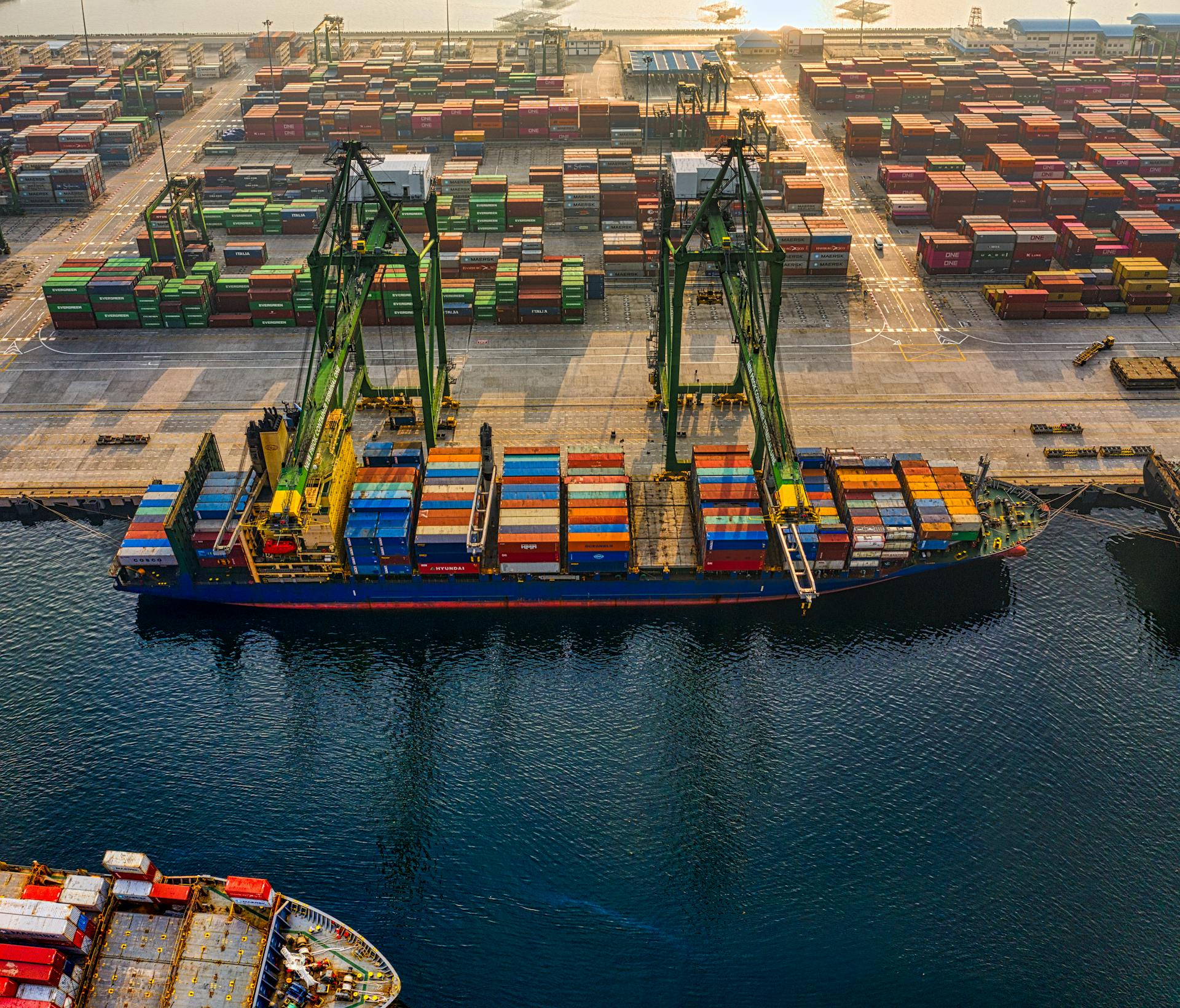
Time charter equivalent (TCE) is a key concept in the shipping industry that can be a bit tricky to understand at first.
TCE is essentially a measure of a ship's daily earnings, taking into account the charter rate, voyage expenses, and other costs.
A TCE of $50,000 per day, for example, means that the ship earns $50,000 per day, after deducting all the expenses and costs associated with the voyage.
This figure is crucial for shipowners and operators, as it helps them determine the profitability of a particular voyage or charter.
What Is?
Time charter equivalent (TCE) is a performance measure that helps shipowners and operators understand how profitable a voyage or charter is on a per-day basis.
It converts the income from various chartering methods into a standard daily rate, making it easier to compare performance across different voyages and charter types.
TCE is expressed in US dollars per day and allows for a more accurate comparison of earnings across different vessel types, charter types, and routes.
The calculation of TCE involves taking the total voyage revenue and deducting voyage expenses such as port charges, fuel costs, and other operating expenses.
The result is then divided by the total number of days in the voyage, providing a normalized daily revenue figure.
TCE enables shipowners, operators, and industry analysts to better understand the profitability of a vessel, considering various factors that can impact earnings.
By using TCE, it is easier to make informed decisions on vessel deployment, chartering, and overall fleet management.
Importance and Uses
Time charter equivalent (TCE) is a vital metric in the maritime industry that provides insight into the earnings of a vessel. It allows for easy comparison between different vessels and charter types, enabling shipping companies to evaluate performance more effectively.
TCE is used to assess operational efficiency and compare earnings across vessels and routes. It provides a standardized measure of profitability beyond raw revenue figures, making it a crucial tool for shipowners and operators.
Shipping companies use TCE to make informed decisions about chartering strategies, budgeting, and forecasting revenue. By understanding TCE, operators can optimize fleet deployment and avoid unprofitable routes.
TCE is also used to evaluate a shipping company's ability to generate consistent cash flow despite volatile freight rates. Investors and analysts monitor TCE to assess a company's financial health.
Here are some key uses of TCE:
- Standardized comparison between vessels and charter types
- Financial planning and budgeting
- Performance benchmarking against industry standards
- Tanker TCE rates for strategic planning and operational adjustments
- Integration with voyage management systems for enhanced TCE calculations
A higher TCE indicates a vessel is generating more income relative to its operating time, allowing operators to optimize fleet deployment and chartering strategies. This is why TCE is a key indicator for stakeholders to assess a company's performance.
Calculating TCE
Calculating TCE is a straightforward process that involves several key steps. The first step is to determine the total number of days for the voyage, including any waiting times at ports.
You'll need to calculate the total voyage revenue by multiplying the total cargo in metric tons by the freight rate per metric ton. For example, if a ship transports 45,000 metric tons of wheat at a freight rate of $14 per metric ton, the total voyage revenue would be $630,000.
On a similar theme: Sea Freight Cost
To calculate the net voyage revenue, you'll need to estimate the voyage expenses, such as fuel costs, port and canal fees, and other expenses. In Example 4, the voyage expenses are estimated to be $225,000.
The net voyage revenue is then calculated by subtracting the total voyage expenses from the total voyage revenue. In Example 4, the net voyage revenue is $330,000.
The final step is to calculate the Time Charter Equivalent (TCE) by dividing the net voyage revenue by the total number of days for the voyage. In Example 4, the TCE is $8,919 per day.
Here's a summary of the TCE calculation:
- Total voyage revenue = Total cargo x Freight rate
- Net voyage revenue = Total voyage revenue - Total voyage expenses
- TCE = Net voyage revenue / Total number of days
By following these steps, you can accurately calculate the TCE for a particular voyage and make informed decisions about chartering options.
Gross Rate and Net Income
The Gross Daily Rate is a crucial metric in ship chartering, but it doesn't tell the whole story when it comes to a vessel's profitability. It's like looking at a snapshot of a business's revenue without considering its expenses.
To get a more accurate picture of a vessel's net income, you need to consider the voyage-related expenses that are not included in the Gross Daily Rate. These expenses can include bunker (fuel) costs, port charges, canal fees, or agency fees. The Time Charter Equivalent (TCE) takes these expenses into account, providing a more realistic representation of a vessel's profitability.
Here's a simple way to think about it: the Gross Daily Rate is like the revenue from a sale, while the TCE is like the profit after deducting all the costs associated with that sale. By comparing the Gross Daily Rate and TCE, shipowners can get a better sense of which chartering options are more profitable.
What is Gross Rate in Shipping?
The Gross Rate in shipping is a crucial concept to understand when navigating the world of ship chartering. It refers to the revenue earned by a vessel per day before deducting any voyage-related expenses. This rate is typically expressed in US dollars per day.

In ship chartering, the Gross Daily Rate is used as a benchmark for comparing the earnings of different vessels or the same vessel operating on different voyages. It's a key factor in determining the profitability of a vessel.
There are two main types of charters: voyage charters and time charters. For voyage charters, the gross daily rate is calculated by dividing the total freight revenue by the total number of days taken for the voyage, including loading and discharging operations.
For time charters, the gross daily rate is simply the agreed daily charter rate between the shipowner and the charterer. This rate doesn't account for operating expenses associated with the voyage.
To give you a better idea, here's a breakdown of how the Gross Daily Rate is calculated for each type of charter:
Keep in mind that the Gross Daily Rate doesn't account for operating expenses such as bunker (fuel) costs, port charges, canal fees, or agency fees.
What Is Net Income?

Net income is a crucial metric in ship chartering, and it's essential to understand what it represents. In simple terms, net income is the profit earned by a vessel per day after deducting all voyage-related expenses from the gross daily revenue.
To calculate net income, you need to start with the Time Charter Equivalent (TCE), which represents the net revenue earned by the vessel per day after accounting for all voyage expenses. These expenses include bunker (fuel) costs, port charges, canal fees, and agency fees.
The TCE is a key component in determining net income, as it provides a comprehensive measure of the vessel's profitability. By subtracting the daily operating expenses from the TCE, you can obtain the net daily income.
Here's the formula to calculate net income:
Net Daily Income = TCE - Daily Operating Expenses
This formula highlights the importance of considering both voyage-related and operating expenses when evaluating a vessel's profitability. By using this formula, shipowners and charterers can make informed decisions about deploying their fleet and evaluating the financial viability of specific voyages or charter options.
Check this out: Norway Yacht Charter as - Båtservice Sightseeing
Operating Costs and EWI

Operating costs can be a significant factor in determining the profitability of a vessel. These costs include variable expenses like fuel consumption and port charges, which can fluctuate with crude oil prices and local tariffs.
Bunker costs, for instance, are directly tied to the price of crude oil and regulations like IMO 2020, which limits sulfur content in marine fuel. Port dues also vary by region and depend on vessel size, cargo type, and local tariffs.
To calculate net earnings, voyage costs are deducted from gross freight income, as seen in the example of a voyage generating $600,000 in revenue but incurring $200,000 in voyage costs, resulting in a net revenue of $400,000 for TCE calculations.
For more insights, see: Marine Fuel Management
Costs
Daily Operating Costs are a crucial part of ship chartering, and they can be broken down into several key components. These costs are essential for maintaining the vessel's functionality, ensuring the safety of the crew and cargo, and meeting regulatory requirements.

Crew wages and provisions are a significant portion of Daily Operating Costs, covering the salaries, benefits, and food supplies for the vessel's crew members. This can be a substantial expense, especially for larger vessels.
Maintenance and repairs are another critical component, including the costs of routine maintenance and repairs, such as spare parts, painting, and dry-docking. This helps keep the vessel in good working condition and complies with industry standards.
Insurance premiums are also a necessary expense, covering risks such as hull and machinery insurance and protection and indemnity (P&I) insurance.
Here are the main components of Daily Operating Costs:
- Crew wages and provisions
- Maintenance and repairs
- Insurance premiums
- Lubricants and consumables
- Management and administration
- Regulatory fees and certifications
- Miscellaneous expenses
Voyage Costs, on the other hand, are variable costs tied to a specific journey, including fuel consumption, port charges, canal transit fees, and agency expenses. These costs can fluctuate with crude oil prices and regulations like IMO 2020.
What Is EWI?
EWI stands for "Estimating Weighted Index" or "Estimated World Index", a term used to describe an index reflecting the average daily earnings of different vessel types operating in the global shipping market.

The EWI takes into account factors such as vessel size, age, trade routes, and prevailing market rates for chartering.
EWI is often used by shipowners, charterers, brokers, and analysts to track market trends and assess the overall health of the shipping industry.
By monitoring the EWI, market participants can gain insights into supply and demand dynamics, freight rate movements, and the overall direction of the shipping market.
It serves as a general indicator of market conditions and average earnings for a particular vessel type or segment, not specific to any individual charter or vessel.
Additional reading: Yacht Charter Service Market
Key Characteristics and Differences
Time Charter involves a fixed term that can range from months to years, whereas Voyage Charter is limited to a single voyage between specified ports.
A Time Charter offers flexible routes and the ability to carry different types of cargo during the charter period. In contrast, Voyage Charter is limited to the specified voyage and its associated cargo.
Here are the key differences between Time Charter and Voyage Charter:
Key Characteristics

Time charters and voyage charters are two distinct types of shipping contracts that serve different purposes.
A time charter is typically for a set period, ranging from months to years.
One of the key benefits of time charters is flexibility in operational planning, as charterers can determine the routes and cargo to be transported.
In a time charter, charterers pay a daily hire rate that includes vessel operational costs, crew salaries, and other expenses.
Voyage charters, on the other hand, are specific to one journey, which can include multiple stops.
The charterer pays a fixed freight rate based on the cargo being transported in a voyage charter.
With a voyage charter, the shipowner retains control over the vessel's operations, including crew management and maintenance.
Here's a comparison of the two types of charters:
Key Differences
Time Charters and Voyage Charters have distinct characteristics that set them apart. A Time Charter involves a fixed term that can range from months to years.
Explore further: Bareboat Rental St Thomas

The duration of a Time Charter can vary significantly, but it's often used for long-term contracts. This type of charter provides stability for shipping companies, making it a popular choice.
Time Charters allow the charterer to have operational control over the vessel during the charter period. This means they have more flexibility to make decisions about the ship's operations.
In contrast, a Voyage Charter is limited to a single voyage between specified ports. This type of charter is more suitable for ad-hoc shipments and operations within the spot market.
The costs associated with Time Charters can be higher due to the longer commitment period. On the other hand, Voyage Charters present a lower commitment with costs based on individual shipments.
Here's a summary of the key differences between Time Charters and Voyage Charters:
Common Applications and Variations
Time charter equivalent (TCE) has a wide range of applications in the shipping industry. Companies that need consistent access to shipping services prefer time charters, which offer stability and operational control.
Long-term contracts are a common use of time charters, benefiting businesses with predictable shipping needs. These contracts can be a game-changer for companies that rely on shipping services to operate their businesses.
Operational control is another key benefit of time charters, allowing companies to manage their logistics without purchasing a vessel. This can be especially useful for businesses that don't have the resources or expertise to manage a fleet of ships.
TCE plays a crucial role in structuring charter agreements, helping shipowners and charterers align financial expectations. By analyzing historical TCE data, charterers can determine whether a proposed rate is reasonable given past performance under similar conditions.
TCE is particularly useful in voyage charter negotiations, where freight rates fluctuate due to demand shifts and bunker price volatility. This makes it essential for charterers to use TCE benchmarks to evaluate whether hiring a vessel aligns with their cost expectations and supply chain needs.
Here are some common variations in TCE calculations:
- Vessel type: TCE calculations vary depending on vessel type, trade route, and contractual terms.
- Trade route: Regional differences impact TCE calculations, with distinct port fee structures, bunker pricing dynamics, and congestion risks affecting standard calculations.
- Contractual terms: TCE calculations are modified to reflect unique cost structures and revenue models in different shipping segments.
For example, LNG carriers factor in boil-off gas consumption, as cargo loss during transit affects earnings. Offshore service vessels, which operate under distinct contract structures, may adjust TCE figures to account for standby periods and mobilization costs.
Requirements and Costs

To calculate Time Charter Equivalent (TCE), shipping companies need to account for revenue, expenses, and operational time.
Gross freight income is one of the primary components of TCE, which includes all revenue earned from a voyage.
Voyage costs, on the other hand, cover variable expenses such as fuel consumption, port charges, and agency expenses. Bunker costs can fluctuate with crude oil prices and regulations like IMO 2020, which limits sulfur content in marine fuel.
Port dues depend on vessel size, cargo type, and local tariffs, varying by region. Some voyages may incur additional expenses, such as ice-class surcharges for Arctic operations.
The total voyage duration, including both laden and ballast legs, is used as the denominator in the TCE formula. Idle periods are excluded unless they result from voyage-related delays, such as waiting for berth availability.
Understanding
TCE is a method for calculating a vessel's daily earnings based on its revenue from a voyage, adjusted for expenses and varying operational conditions.
This calculation is essential for shipping operations, as it provides a standardized daily revenue figure for each vessel, which directly feeds into Profit and Loss (P&L) statements.
By expressing earnings on a daily basis, TCE facilitates comparisons between different vessels, routes, and charter agreements, making it a crucial tool for shipowners and operators.
TCE calculations can be time-consuming and prone to errors when done manually, which is why a Voyage Management System (VMS) like ClearVoyage is recommended to simplify the process.
A VMS centralizes data, automates TCE calculations, and provides real-time insights into voyage performance, ensuring accurate and up-to-date calculations.
With a VMS, you can track revenue, expenses, and voyage durations, making it easier to identify areas where costs are rising and take steps to mitigate them.
Example and Calculation
To calculate the Time Charter Equivalent (TCE), you need to know the freight earnings, voyage duration, and operating costs. The TCE is calculated by dividing the voyage cashflow by the voyage duration and adding the operating costs.
A Supramax vessel, for example, earned $875,000 in freight earnings, but had to pay $148,000 in operating costs, leaving a voyage cashflow of $443,062.5. The TCE for this vessel is $15,974.67 per day, calculated by dividing the voyage cashflow by the 37-day voyage duration and adding the $4,000 per day operating costs.
The TCE calculation is essential for optimizing maritime operations and benchmarking during decision-making. It allows shipping companies to compare the profitability of different voyages and vessel types.
A Handysize vessel, on the other hand, earned $567,000 in freight earnings, but had to pay $70,000 in operating costs, leaving a voyage cashflow of $304,912.5. The TCE for this vessel is $13,389.74 per day, calculated by dividing the voyage cashflow by the 28-day voyage duration and adding the $2,500 per day operating costs.
For example, if a vessel has earned $500,000 in voyage revenue and the total voyage expenses amount to $150,000, the TCE is $17,500 per day, calculated by dividing the voyage cashflow by the 20-day voyage duration.
You might like: Just in Time Delivery Example
Advantages and Disadvantages
Time charter equivalent is a complex topic, and understanding its advantages and disadvantages is crucial for making informed decisions.
There are both advantages and disadvantages of voyage charters, as mentioned in the article section.
One of the main advantages of voyage charters is that they allow shipowners to earn revenue without having to commit to a long-term charter.
Voyage charters can be beneficial for shipowners who have a fleet of ships and want to maximize their earnings.
However, voyage charters also have a disadvantage - they can be unpredictable, as the shipowner may not have control over the cargo or the route taken.
The unpredictability of voyage charters can be a major disadvantage, as it can make it difficult for shipowners to plan and budget for the future.
Sources
- https://heisenbergshipping.com/time-charter-equivalent-tce/
- https://clearvoyage.com/resources/understanding-time-charter-equivalent
- https://www.handybulk.com/tce-time-charter-equivalent/
- https://clearvoyage.com/resources/time-charter-vs-voyage-charter
- https://accountinginsights.org/what-is-time-charter-equivalent-and-how-is-it-calculated/
Featured Images: pexels.com


